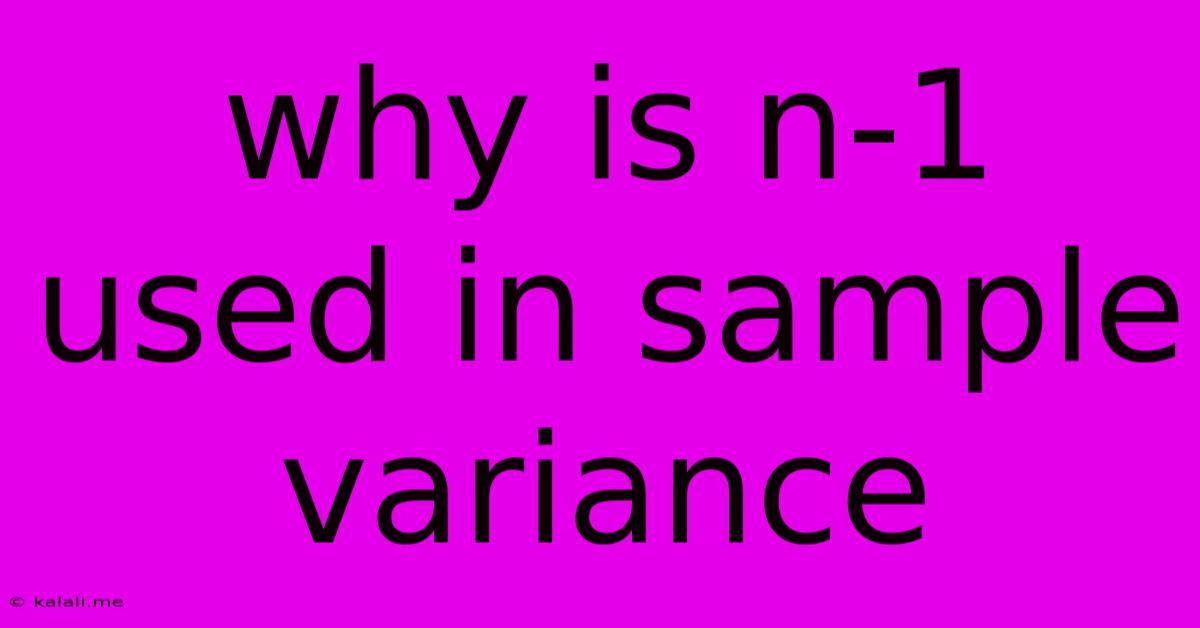Why Is N-1 Used In Sample Variance
Kalali
May 31, 2025 · 3 min read

Table of Contents
Why is N-1 Used in Sample Variance? Understanding Bessel's Correction
Calculating variance is a crucial step in statistics, helping us understand the spread or dispersion of a dataset. While population variance uses 'N' (the total number of data points), sample variance uses 'N-1', a seemingly arbitrary adjustment known as Bessel's correction. This seemingly small change significantly impacts the accuracy of our estimations, and understanding why it's used is essential for anyone working with statistical data. This article will delve into the reasons behind this crucial correction, exploring its mathematical basis and practical implications.
The core reason for using N-1 instead of N in sample variance calculations boils down to unbiased estimation. Let's break down what this means. When we take a sample from a larger population, we aim to use that sample to estimate the characteristics of the entire population. If we use 'N' in the sample variance formula, our estimate will consistently underestimate the true population variance. This is because the sample mean, used to calculate the variance, is itself an estimate of the population mean.
The Problem with Using 'N': An Underestimation Bias
Imagine you're calculating the sample variance. You're using the sample mean as your center point. Since the sample mean is calculated from the sample data itself, it will always be closer to the data points in your sample than the true population mean. This means the deviations (differences between each data point and the mean) will tend to be smaller when using the sample mean compared to the true population mean. Consequently, the variance calculated using 'N' will be systematically smaller – a biased estimate.
Bessel's Correction: The Solution
Bessel's correction addresses this bias by using 'N-1' instead of 'N' in the denominator of the sample variance formula. This simple change effectively increases the calculated variance, bringing it closer to the true population variance. Mathematically, using N-1 provides an unbiased estimator of the population variance. This means that, over many samples, the average of the sample variances calculated with N-1 will converge to the true population variance.
Why N-1? A Deeper Dive into the Mathematics
The mathematical proof behind Bessel's correction is beyond the scope of a simple blog post, involving concepts of expected values and unbiased estimators. However, the core idea is that using N-1 adjusts for the loss of a degree of freedom. We lose one degree of freedom because we're using the sample mean to calculate the variance. The sample mean itself is constrained by the data in the sample; it's not independent. Using N-1 accounts for this constraint, leading to a less biased estimate.
Practical Implications of Bessel's Correction
Using N-1 significantly impacts the accuracy of our statistical inferences, particularly in smaller samples. While the difference might be negligible with very large samples, it becomes crucial when working with smaller datasets. Accurate estimation of variance is crucial for various statistical analyses, including:
- Hypothesis testing: Inaccurate variance estimations can lead to incorrect conclusions in hypothesis tests.
- Confidence intervals: The width of confidence intervals depends heavily on the variance, and using an unbiased estimate is essential for accurate intervals.
- Regression analysis: Variance plays a key role in determining the goodness of fit of regression models.
In Conclusion
Bessel's correction, the use of N-1 in sample variance calculations, is not an arbitrary adjustment but a crucial step in obtaining an unbiased estimate of the population variance. It accounts for the limitations of using a sample mean to estimate the population mean, leading to more accurate and reliable statistical analyses, particularly when dealing with smaller sample sizes. Understanding this correction is fundamental to accurate statistical inference and data analysis.
Latest Posts
Latest Posts
-
Diy Garage Ventilation System For Resin Printer
Jun 02, 2025
-
How To Remove Stamp Ink From Skin
Jun 02, 2025
-
How To Keep Eyeglasses From Slipping Down Nose
Jun 02, 2025
-
Teach Your Grandmother To Suck Eggs
Jun 02, 2025
-
V For Vendetta V And Evey
Jun 02, 2025
Related Post
Thank you for visiting our website which covers about Why Is N-1 Used In Sample Variance . We hope the information provided has been useful to you. Feel free to contact us if you have any questions or need further assistance. See you next time and don't miss to bookmark.